CROP PRODUCTION
Coconut
- Improvement in water and nutrient use efficiency in coconut through location-specific drip fertigation schedules
Aliyarnagar:
Based on the studies conducted at CRS, Aliyarnagar, water requirement of coconut was standardized for Western region under drip irrigation system:
| Months | Quantity of water to be applied (lit/day) | ||
| Adequate water available area | Moderate water available area | High water scarcity area | |
| Feb-May | 65 | 45 | F22 |
| Jan, Aug and Sep. | 55 | 35 | 18 |
| June, July, Oct-Dec. | 45 | 30 | 25 |
Veppankulam:
- For basin irrigation, 410 litres of water/palm once in 5-7 days during March - September and once in 8-10 days during October to February is optimum for eastern region of Tamil Nadu depending upon the soil type.
- In drip irrigation, 80 litres/day/palm during March-September and 50 litres / day / palm during October - February is sufficient for eastern region of Tamil Nadu.

Drip irrigation for coconut
Arsikere:
- Drip irrigation requirement of coconut: Drip irrigation at 100% Eo is ideal for coconut in maidan tract of Karnataka. The water to be applied during summer months (February-May) is 65-75 litres per palm per day while for winter and rainy months (June-January) is 40-50 litres/palm/day.
Ratnagiri:
- Irrigation to coconut palm by drip method: The drip irrigation with 30 liters water /palm/day during October to January and 40 liters during Feb to May with six drippers placed at a distance of 1.25 m away from the bole in the sandy loam soils of Konkan region is recommended for adult coconut palm.
- Improvement in water and nutrient use efficiency in coconut through location-specific drip fertigation schedules
Based on the studies taken up on fertigation in coconut at different Centres of AICRP on Palms from 2007-08 to 2012-13, the following recommendations have been made for different regions of the country.
- Aliyarnagar, Veppankulam, Mandouri and Kasaragod Centres: The nut and copra yield per palm per year in fertigation of 50% recommended dose of fertilizer (RDF) was on par with fertigation of 75% RDF and soil application of 100 per cent RDF. Hence, fertigation of 50% RDF can be recommended. Thus, there was reduction in the cost of production and increase in WUE and FUE.
- Ambajipeta, Ratnagiri, Arsikere Centres: Application of 75% RDF through fertigation recorded significantly higher nut and copra yield per palm per year compared to soil application of 100% RDF and on par 100% RDF through fertigation. Hence, drip fertigation of 75% RDF can be recommended. Thus, there was reduction in the cost of production and increase in WUE and FUE.
- By improving the water and nutrients utilization, which can reduce the cost of production by 15 to 20 %, increase the productivity of the system by 25 to 30 % and resulted in maximum utilization of available natural resources.
- Integrated Nutrient Management package have been recommended for the cultivation of hybrids in different regions
- A fertilizer dose of 1000:250:1000 gram NPK/palm/year is recommended for the cultivation of Dwarf x Tall coconut hybrids in interior Tamil region; 50 % of the recommended nitrogen dose could be applied as organic manures (Vermicompost) and the balance NPK could be applied as inorganic fertilizers.
- A fertilizer dose of 500:500:2000 gram NPK/palm/year is recommended for the cultivation of Dwarf x Tall coconut hybrids in irrigated coconut gardens in Assam state; 50 % of the recommended nitrogen dose could be applied as organic manures (vermicompost) and the balance NPK could be applied as inorganic fertilizers.
- A fertilizer dose of 1000:500:1000 gram NPK/palm/year is recommended for the cultivation of Dwarf x Tall coconut hybrids in irrigated gardens in the new Alluvial Zone (West Bengal) and Konkan coastal region (Maharashtra); 50 % of the recommended nitrogen dose could be applied as organic manures (vermicompost) and the balance NPK could be applied as inorganic fertilizers.
- Integrated nutrient management packages for the cultivation of coconut in different regions
- Interior TN: 100 % N requirement (composted coir pith) and the balance requirement of P&K could be applied as chemical fertilizers.
- Coastal Tamil Nadu: 50 % N requirement through composted coir pith and the balance requirement of N, P&K could be applied as chemical fertilizers.
- Andhra Pradesh: 50% N requirement through composted coir pith and the balance requirement of N, P&K could be applied as chemical fertilizers.
- Karnataka: 100 % N requirement through composted coir pith and the balance requirement of P&K could be applied as chemical fertilizers.
- Odisha: 50 % N requirement through composted coir pith and the balance requirement of N, P&K could be applied as chemical fertilizers.
- Konkan region: For organic coconut production in Konkan region, application of vermicompost (prepared from coconut leaves and other available biomass) @ 50kg per bearing coconut palm during the last week of May or first week of June by basin method is recommended.
By adopting integrated nutrient management packages, there was increase in the productivity of the system by 30 to 40 % and there was improvement in the soil properties.
- Evolving location-specific coconut based cropping systems:
-
a) Coconut based cropping system comprising of following crops have been recommended for different regions:
S.No Cooperating centre’s Coconut based cropping system 1 Aliyarnagar
(Tamil Nadu)Coconut+banana+turmeric+EFY+pineapple+Tapioca+ Bhendi 2 Veppankulam
(Tamil Nadu)Coconut + black pepper + banana + elephant foot yam + coriander 3 Mondouri
(West Bengal)Coconut-black pepper-pineapple 4 Bhubaneshwar
Odisha)Coconut + banana + tube rose (in young coconut garden) 5 Jagdalpur
(Chhattisgarah)Coconut + black pepper + carnation + chrysanthemum 6 Kahikuchi
(Assam)Coconut + black pepper + turmeric 7 Konkan region of Maharashtra Coconut + Turmeric + banana + pineapple + tapioca 8 Arsikere
(Karnataka)Coconut+ banana + drumstick + french bean+ ladies finger + redgram.
Depending on the irrigation water potential available in the coconut gardens of maidan tract of Karnataka, the following intercrops are recommended for cultivation in coconut gardens
Coconut- banana (High water requirement)
Coconut – annual drumstick (Medium water requirement)
Coconut – red gram ( low water requirement)
9 Navasari
(GujaratCoconut + Turmeric b) Intercropping with region specific medicinal and aromatic crops in coconut garden was also found to increase income of coconut farmer with the following crops.
S.No Cooperating centre’s Coconut based cropping system 1 Ambajipeta Palmarosa, Mango ginger, Patchouli, Citronella 2 Aliyarnagar Galanga, Lemon grass, Patchouli 3 Arsikere Lemon grass, Garden rue, Tulsi, Kalmegh, Arrow root and Makoi 4 Kahikuchi Pipali, Patchouli, Citronella, Sarpagandha 5 Mondouri Sarpagandha, Aswagandha, Arrowroot 6 Ratnagiri Sathavari, Adulsa, Arrow root, Lemon grass, Citronella 7 Veppankulam Aloe , Galangal, Tulsi 8 Jagadalpur Stevia, Amahaldi, Sarpagandha,Tikhur,Patchouli 9 Bhubneshwar (Odisha) Stevia and Artensia c) Coconut bases high density multispiecs cropping system( CBHDMSCS)
A suitable model of coconut based high density multispecies cropping system has been established for different agro climatic regions. This model was found to be profitable and highly sustainable. List of crop combination of HDMSCS for different centre has been give below:
S.No Cooperating centre’s Coconut based cropping system 1 Aliyarnagar Coconut + Cocoa + Banana + Moringa + Pineapple 2 Ambajipeta Coconut + Cocoa + Banana + Pine apple + Tomato 3 Arsikere Coconut + Banana + Drumstick + Cocoa+ Lime 4 Bhubaneshwar Coconut + Guava + Banana + Pine apple 5 Jagdalpur Coconut + Guava + Cinnomon + Banana + Colocasia + Bottle gourd (Summer) + Mango ginger + Cowpea (Summer) + Elephant foot yam 6 Kahikuchi Coconut + Black Pepper + Turmeric + Banana + Assam Lemon+ pineapple + Elephant foot yam 7 Mandouri Coconut + Black Pepper + Lime + Pine apple + Banana + Turmeric + Elephant foot yam. 8 Navsari Coconut +Black pepper+ Cinnamon + colocasia + Elephant foot yam + Turmeric + Banana
BENEFITS OF Coconut Based Cropping System
Social benefits are the food and nutritional functions of fresh nuts of coconut and coconut products, and crops produced under CBCS. With CBCS, the same coconut lands can be used to produce various crops: 1) cereals (as source of carbohydrates, protein, fats and oils); 2) root crops (as source of carbohydrates and minerals); 3) legumes (as source of protein and vegetable fats and oils) 4) fruit crops (as rich source of vitamins and minerals, and carbohydrates); 6) spice crops (food flavouring and vitamins and minerals); 7) coffee and cocoa (beverage and stimulants); 8) natural fibre crops (clothing materials and paper and packaging); 9) wood and timber (housing materials, pulp and paper)
Compared to the ecological conditions of the long-term mono cropping those of lands under CBCS are more favourable and stable for intensive and sustainable agricultural production. This is highly attributed to more efficient utilization of the land resources as a result of: 1) maximization of solar energy capture; 2) optimization of soil moisture use and retention capacities; 3) enhancement of soil fertility build up due to higher biomass generation over time; and 4) minimal soil erosion and nutrient losses largely attributed to effective and efficient crop canopies and root system
Coconut based cropping systems at different centres
Aliyarnagar
 | ||
| Coconut based high density multispecies cropping system |
Nutmeg intercropped in coconut | Pineapple as intercrop in coconut garden |
Ambajipeta
 | |
| Banana as intercrop | Pineapple as intercrop in coconut |
Arsikere
 | ||
| Coconut + Banana | Coconut + Drum stick | Coconut + French bean |
Jagdalpur
 | |
| Intercrop in Kharif season Intercrop in Rabi season (Elephant foot yam) |
Kahikuchi
 | |
| Coconut based HDMSCS |
Navasari
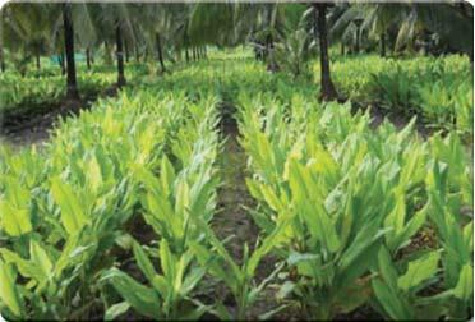 |
| Turmeric as intercrop |
Ratnagiri
 |
| Turmeric as intercrop |
Veppankulam
 | |
| Coconut + Turmeric + Banana | Coconut + Bhendi |
 | |
| Coconut + Yam + Banana | Inter crop in Coconut |
Mandouri
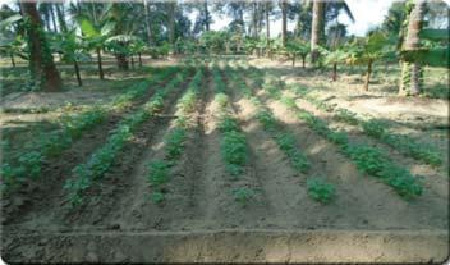 | 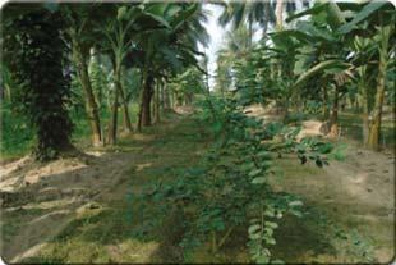 |
| Potato as inter crop in coconut | Coconut intercropped with lemon, onion, black pepper , banana |
Medicinal and Aromatic plants as intercrop in coconut garden
Arsikere
 | ||
| Garden rue | Tulsi | |
Veppankulam
 | ||
| Coconut based cropping system with MAP’s | Lemon grass | |
Ambajipeta
 | ||
| Patchouli | Citronella | |
Aliyarnagar
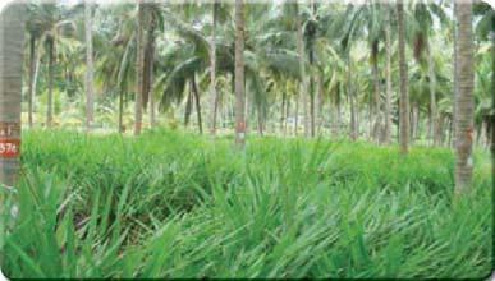 |
| Alpinia galanga as intercrop in coconut garden |
Kahikuchi
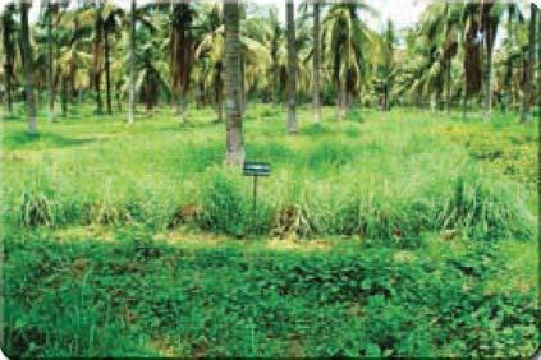 |
| Coconut based cropping system with M & AP’S |
Oil Palm
Gangavathi:
- A fertilizer dose of 1200:600:1200 N,P2O5 and K2O/palm/year was found optimum for oil palm under irrigated condition of Tungabhadra command area.
- Water requirement for adult Oil palm worked out and is as follows:
Months Water requirement (day/palm) Basin irrigation Drip irrigation July - October 110-140 55-70 November - February 90-130 45-65 March - June 150 - 220 75 - 110 - Fertigation of 1200:600:1200 N,P2O5 and K2O/palm/year through drip in 6 equal splits was found optimum for oil palm under irrigated condition of Tungabhadra Command Area
Mulde:
- On the basis of 18 years study (1989 -2007) on fertilizer and irrigation requirements for oil palm under Maharashtra conditions following recommendation was given.
For successful cultivation of Oil Palm under Konkan conditions of Maharashtra, irrigation is recommended during winter (Oct- Jan) @ 50 l /day/palm through drip or 400 l/plant at four days interval through basin. During summer (Feb- May) irrigation is given @ 80 l/palm/day through drip or 630 l /palm/through basin at four days interval along with the fertilizers @ 1200, 600, 2700 g NPK per palm per year respectively. - Yield data for five years ( 2009-2013) revealed that there was no significant difference among the various fertigation treatments for yield characters. However, treatment 1200; 600; 1800 g NPK through fertigation (T5) recorded highest number of bunches and highest yield 18.3 t/ha to 21 t/ha.
Pattukkotai:
- Fertilizer application through micro-irrigation technique in oil palm: The results revealed that treatment with 1200:600: 1800 g of NPK through fertigation recorded more stem girth, number of leaves / palm and FFB.
Vijayarai:
- Basin irrigation recorded maximum FFB yield of 18 t/ha over flood irrigation.
- The water use efficiency was higher in drip irrigation treatment with 682.3 kg-ha/cm.
- The FFB yield was increased by 18.7 t/ha at higher dose of 1200+600+2700 g NPK/palm/year which was recommended to the farmers as technology.
- The fertilizer dosage 1200:600:1200 g NPK through fertigation recorded maximum FFB yield of 124.7 kg/palm/year
9.3.3. Palmyrah
- Under defoliation studies self-sown, on farm trees aged between 25 - 35 years were utilized for the study. Existing on farm palms have been divided in to three blocks and are labeled. Each block contained 25 palms and 5 palms were used per each treatment with in the block. From the tapping results from the four years data it has been found that highest neera yields have been recorded with 30% defoliation treatment which was followed by control. Lowest yield of neera was recorded with 90% defoliated palms. Among the three months tapped highest neera yields were recorded during February followed by January.
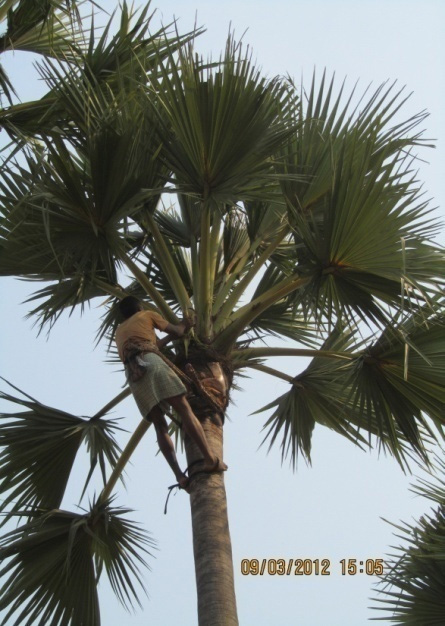
30% defoliated palmyrah palm - In palmyrah simple removal of mesocarp enhanced the percentage of germination by 15 percent and the percentage of germination of seed nut ranged from 35.83 to 96.62 in Palmyrah.
- Storing of Palmyrah seed nuts for a period of 30 days in shade improved the germination (79%) while, the seeds sown immediately after harvest recorded only 51 % germination.
- Among the four rooting media tested, to assess their suitability for nursery, pot mixture (Sand, Silt, FYM @ 1: 1: 1) was found to be superior, since the nut germination (77%) and tuber vigour were found to be the highest in the medium.
- 50 Kg FYM + 500 g of NPK recorded 82 litres of padaneer (sweet sap) / tree and 105 fruits per palm.
- Among 8 accessions continuously evaluated for padaneer yield for 10 years from 1995 – 2004, the accession BF34 (female) yielded the maximum of 287.850 litres of padaneer in a tapping duration of 85 days with a mean of 176.9 lit followed by BF.36 (male) recording a maximum of 237.7 lit. with an average of 113.8 lit. and the yield was consistent even in drought years.
- The optimum period for tuber maturity was found to be 135 days after sowing.
- The neera yield from individual inflorescence ranged from 21.750 lit. to 69.466 lit. in a tapping duration ranging from 57.5 to 65.0 days. It is also evident that the neera yield may be high when the total number of inflorescences produced per tree is low
- The neera obtained from male tree had comparatively higher values for specific gravity, ash content, ascorbic acid, calcium and phosphorus than female one.
- Root feeding studies with coconut tonic showed that the thin and brittle roots seen in the upper soil surface were found not effective in absorbing the tonic and the feeder roots were seen only at a depth of > 90 cm from the soil surface. The feeder roots of young palms (< 10 years) took more than 24 hours to absorb the tonic whereas; the older palms took only 5-6 hours for complete absorption of the tonic.
- Root studies were carried out in palmyrah trees of varying age groups. The age of the trees is 5,10,15,20 and 25 years. The number of roots in each zone of different age group of trees were recorded .The number of roots was more as the age of the tree advanced. Zone A1 recorded higher number of roots for all the years. The highest number of roots were recorded in 20 year old trees. No roots were found in 5,10 and 15 year old trees in C Zone level.
